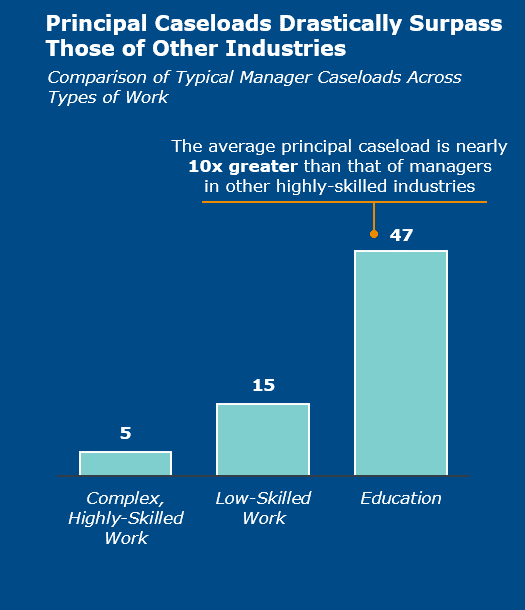The principal role has become increasingly demanding in recent years, but with the outbreak of COVID-19, the job has only grown in complexity and difficulty. Leading successful schools during the current crisis and through the next school year requires highly effective principals and leadership teams who can prepare for and adapt to current and future disruptions.
It’s unsurprising then that relying on any one person—as qualified and capable as that person may be—is often an unsustainable approach to school leadership.
For this reason, some districts have begun distributing key instructional leadership opportunities among high-quality teachers. This enables districts to retain top talent in the classroom and principals to spend more time on strategic school initiatives.
Current school leadership models rely too heavily on principals

For decades, principals have been entrusted with ultimate responsibility for all aspects of a school. Most principals are expected to oversee more staff than is typically manageable; compared to managers in other complex work, the average principal caseload is nearly ten times larger.
And though the majority of District Leadership Forum partners report that “instructional leadership” is a major goal for their districts, they often expect their principals to lead instruction on their own. The majority of principals not only view themselves as, but are required to be, the primary person responsible for influencing their teachers’ performance and growth. As a result, many principals wish they had greater capacity to focus on their schools’ other strategic goals.
Distribute key instructional responsibilities to teacher leaders
Some districts have successfully embraced alternative leadership models that have allowed for more efficient and effective school leadership. In a distributed leadership model, the principal authorizes other leaders to make decisions and encourages those leaders to become experts in their designated area of the school’s operations.
Denver Public Schools distributes key instructional responsibilities to teacher leaders who each oversee, coach, and develop a team of teachers in a model called “Teacher Leadership and Collaboration.”
Leaders at Denver Public Schools maximize principal time and capacity by deploying high-quality teachers as instructional experts. These teacher leaders, called Team Leads, provide instructional support to their fellow teachers. They spend half of their time teaching and are given release time to spend the other half observing, coaching, and providing in-the-moment feedback to their team of teachers.
The Art of Focused Feedback
Provide faculty with observations that are quick, clear, and actionable to improve their professional practice
GET THE INFOGRAPHICThough the principal is still expected to occasionally co-observe with Team Leads and provide job-embedded feedback when possible, these teacher leaders are ultimately responsible for helping their team of teachers develop and improve.
Offer a range of leadership opportunities to teachers beyond school administration
Denver Public Schools has also created other intermediate leadership positions that fall under the purview of the Team Leads. For instance, New Teacher Ambassadors support the first-year teachers on their team by connecting them to resources and providing social-emotional support. Additionally, Team Specialists co-plan lessons with their teams and serve as experts on aligning instruction to educational standards.
All teacher leaders earn stipends based on their roles and undergo intensive training each summer. To be selected, teachers must demonstrate exceptional classroom teaching and participate in the district’s competitive application process.

86%
Strengthen teacher leadership to maximize principal efficacy and instructional impact
Denver’s reimagined leadership model has maximized principals’ capacity to focus on the strategic, high-priority aspects of their schools as well as strengthened teachers’ instructional expertise.
Denver district leaders have noted that principals now have more time to focus on strategic innovation and initiatives. They have also seen a consistent difference between teachers who are on a team led by a teacher leader and their students’ growth compared to those who aren’t. They’ve noticed a higher retention rate for those teachers categorized as “distinguished” by the district’s growth and performance system as well as improved retention for the teachers in the district’s highest-needs schools.
“Now principals spend a lot more time talking and thinking about instructional improvement with their leadership teams. They’re no longer the sole person responsible for the supervision of 40 people in their buildings. They’re freed up to think more strategically.”
Sarah Almy, Executive Director of Teacher & Leader Learning, Denver Public Schools
This leadership model was originally piloted in select schools in the 2013-14 school year, but due to its success, the program continues to grow throughout the district each year. The principal position has always been one of—if not—the most difficult in education. And that was before a pandemic worsened inequities, multiplied the social-emotional needs of our students, and elevated questions about instructional technology. A teacher leadership model, like the one at Denver Public Schools, has the potential to relieve some of the pressure on principals so they can focus on leading their schools through this difficult time and into the future.
Review these key action steps to expand teacher leadership in your district
Denver’s primary purpose has been to increase the quality and frequency of instructional coaching for teachers to ensure consistent, rigorous instruction in all classrooms.
District leadership designed the career ladder, wrote the corresponding job descriptions, and delineated the ideal success metrics for each new role.
Denver mandated that all teacher leaders continue teaching at least part-time to ensure their own growth in the classroom.
District leaders in Denver emphasized that getting teachers on board is critical, but it’s also important not to overlook principal supervisors and other district-level administrators.
Training teacher leaders in best practices and newly identified competencies is essential for success; leaders at Denver Public Schools recommend focusing much of this preparation on the art of providing meaningful coaching and feedback.